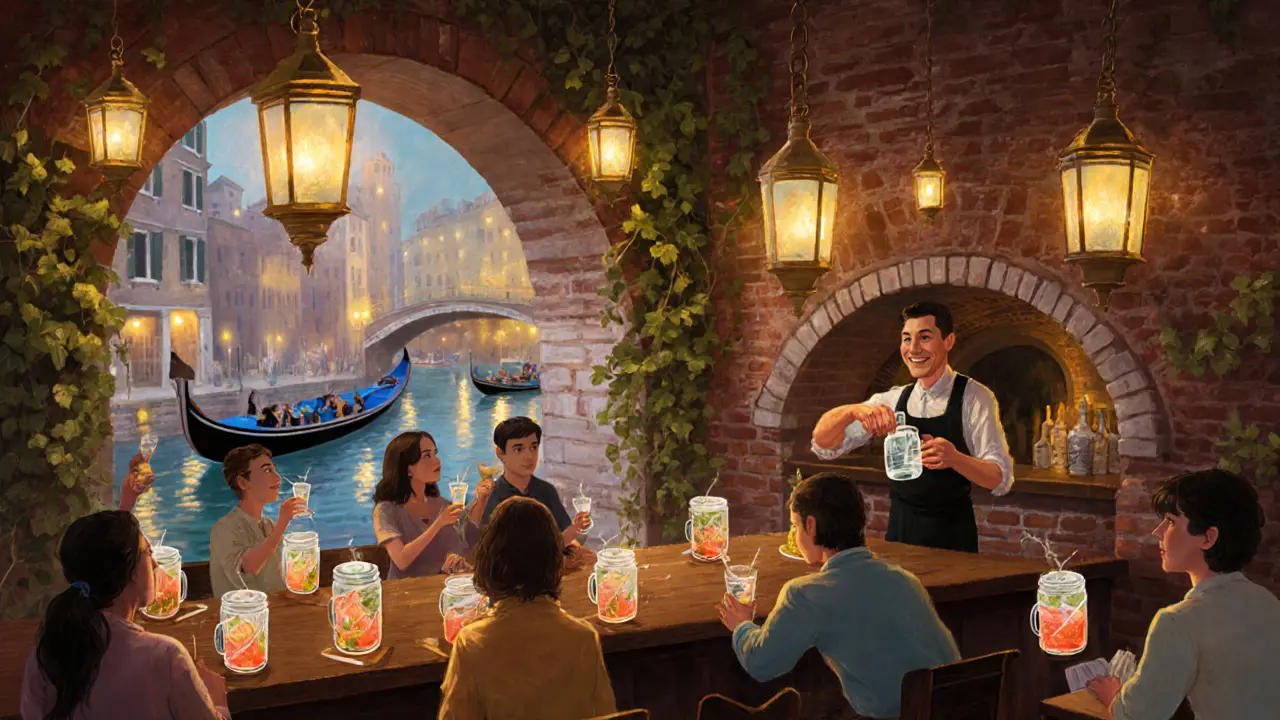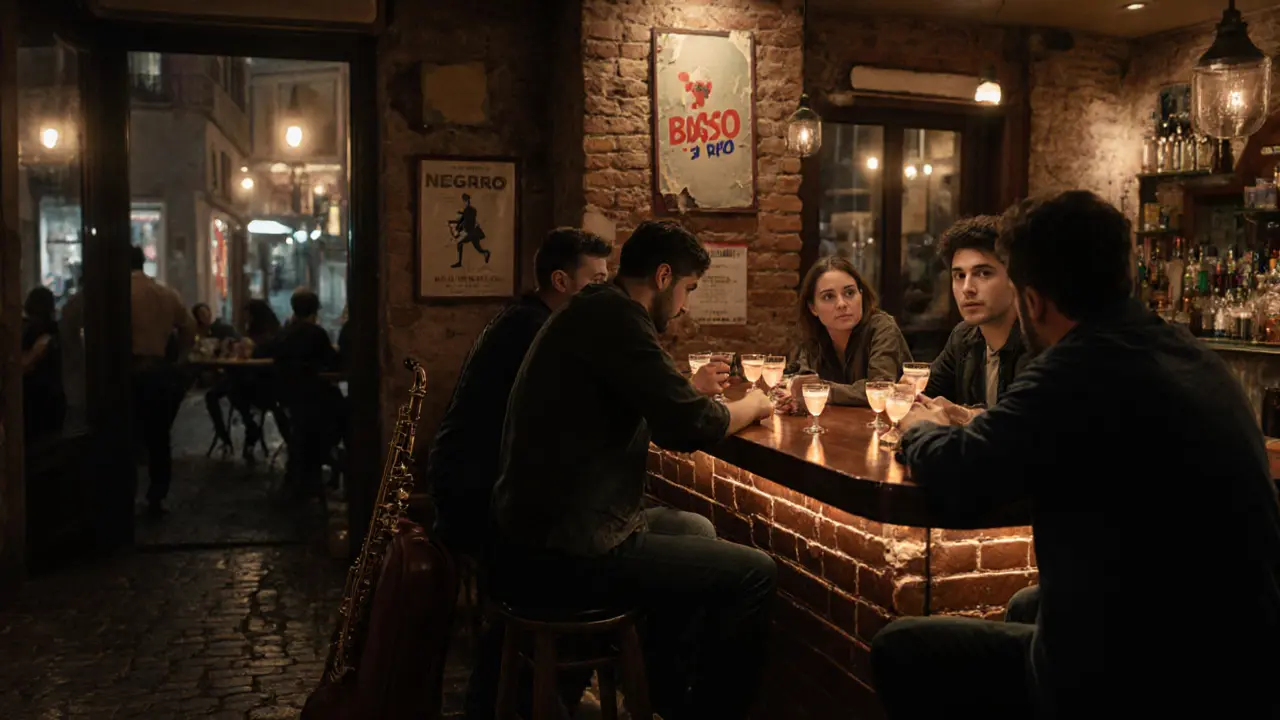Most people think Milan is all about fashion shows, luxury boutiques, and quiet espresso bars. But when the sun goes down, the city transforms. The real Milan doesn’t show up on postcards. It’s in the back alleys of Brera, the rooftop terraces of Navigli, and the underground jazz cellars tucked under old train tracks. If you’re looking for a night out that feels like you’ve stumbled into a local’s secret, you’re in the right place.
Brera: Where Art Meets After-Dark
Brera isn’t just a neighborhood-it’s a mood. By day, it’s galleries and cobblestone streets lined with antique shops. By night, it becomes Milan’s most intimate nightlife zone. Skip the tourist traps on Via Brera. Instead, head to Bar Basso, the birthplace of the Negroni Sbagliato. It’s small, dim, and packed with locals who’ve been coming here since the 1980s. The bartenders don’t smile much, but they know exactly how to pour your drink. Order the Sbagliato-sparkling wine, Campari, and a splash of vermouth-and watch how the room fills with designers, musicians, and writers who never leave until 3 a.m.
Just down the street, La Permanente is a hidden jazz club with no sign. You’ll know you’ve found it by the low hum of saxophone drifting from a narrow doorway. Inside, it’s all leather booths, vintage vinyl, and a crowd that doesn’t talk over the music. No cover charge. No VIP section. Just pure, unfiltered jazz from local bands who’ve played here for over a decade.
Navigli: Canals, Cocktails, and City Lights
If you want to walk along water with drinks in hand, Navigli is your spot. The canals here used to carry goods in the 1500s. Now they carry cocktails. The stretch between Darsena and Porta Ticinese is where the real action is. Don’t go on a Friday night unless you like crowds. Go on a Tuesday or Wednesday instead.
La Zanzara is the most talked-about bar in the area. It’s a converted warehouse with wooden floors, hanging lanterns, and a backyard that spills right onto the canal. Their signature drink? The Navigli Spritz-Aperol, Prosecco, and a twist of orange, served in a mason jar. The staff don’t write down your order. They remember your face. And if you come back, they’ll know your usual.
For something quieter, try Il Giardino Segreto-a tiny garden bar hidden behind a green door. No menu. Just ask the bartender what’s fresh. They’ll make you something with local herbs, gin from Lombardy, and a splash of elderflower. It’s the kind of place where you end up talking to strangers who become friends by midnight.
Porta Ticinese: Industrial Vibes and Underground Beats
Porta Ticinese is where Milan’s edgier side lives. Think exposed brick, concrete floors, and bass you feel in your chest. This isn’t the place for bottle service or designer dresses. It’s for people who want to dance until their shoes stick to the floor.
Teatro del Silenzio is a warehouse-turned-club that only opens on weekends. The name means “Theater of Silence,” but inside, it’s anything but. DJs spin techno, house, and experimental sounds pulled from Milan’s underground scene. The crowd? Artists, students, and expats who’ve been here since the early 2000s. No bouncers. No dress code. Just a line that forms after 11 p.m. and a sound system that shakes the walls.
For a drink before the beat drops, head to Bar Luce. It’s a retro café with Formica tables and a jukebox full of 70s Italian pop. Order a Campari Soda and sit by the window. Watch the street come alive as the night builds.

Centro Storico: Rooftops and Real Milan
Most tourists head to the Duomo for photos. Locals head to the rooftops above it. Terrazza Aperol sits atop a 1920s building near Piazza del Duomo. It’s not the fanciest rooftop, but it’s the most authentic. The view? The cathedral lit up in gold. The crowd? Milanese professionals in jeans, not suits. The drinks? Aperol Spritzes at €8.50. That’s half the price of the tourist spots.
For something more exclusive, Skyline Lounge requires a reservation. It’s small-only 40 seats. The mixologists here craft drinks with ingredients like bergamot from Sicily and honey from the Alps. Their signature? The Milanese Sunset: gin, saffron syrup, and sparkling water. It’s served in a chilled glass with a single edible flower. You won’t find this on Instagram. You have to be invited.
What to Avoid
There are plenty of places that look cool but feel like a theme park. Avoid La Scala Bar near the opera house-it’s overpriced, loud, and full of people waiting to be seen. Same with the clubs near Corso Como that charge €50 just to get in and serve you the same vodka tonic as every other city in Europe.
Also skip the “Milan Night Tour” buses. They drop you off at the same three spots every night. You’ll see the same people. The same DJs. The same energy. Real Milan doesn’t need a tour guide.

When to Go
Weekdays are better than weekends. Friday and Saturday are packed, especially in Navigli and Brera. Tuesday and Wednesday are when the locals have the place to themselves. Bars are quieter, drinks are cheaper, and the vibe is more relaxed.
Start late. Most places don’t fill up until after 11 p.m. Dinner at 8, a drink at 10, then move to the next spot. The real nightlife doesn’t start until midnight.
How to Get Around
Milan’s metro shuts down at 1 a.m. After that, you’re on your own. Grab a taxi via the FreeNow app-it’s cheaper than Uber here. Or walk. The city is safe, well-lit, and compact. Brera to Navigli is a 20-minute stroll. Navigli to Porta Ticinese? 15 minutes. You’ll see more of the city walking than you ever will in a cab.
Final Tip
The best night in Milan doesn’t happen in a club. It happens when you’re sitting on a bench by the canal, sipping something local, and someone you just met tells you about the jazz bar they discovered in 2012 that no one else knows about. That’s the secret. It’s not about where you go. It’s about who you meet-and how late you stay.
What’s the best time to visit Milan for nightlife?
The best time is from April to October. The weather is mild, and outdoor bars in Navigli and Brera are fully open. Weekdays-Tuesday to Thursday-are quieter and more authentic than Friday and Saturday nights, which get crowded with tourists and party groups.
Is Milan nightlife expensive?
It can be, but it doesn’t have to be. In tourist zones, a cocktail can cost €15 or more. But in local spots like Bar Basso or La Zanzara, you’ll pay €8-€10 for a well-made drink. Many bars don’t charge cover fees, and some even have happy hours from 7 to 9 p.m. Stick to the hidden spots, and you’ll save money without sacrificing quality.
Do I need to dress up for Milan nightlife?
Not really. Milan is stylish, but it’s not about flashy outfits. Smart casual works everywhere-dark jeans, a nice shirt, clean shoes. In upscale spots like Skyline Lounge, avoid flip-flops or shorts. In underground clubs like Teatro del Silenzio, you can wear sneakers and a hoodie. The key is looking put-together, not overdressed.
Are there any LGBTQ+-friendly spots in Milan?
Yes. Bar Puccini in Navigli is a long-standing LGBTQ+ favorite with drag shows on weekends and a welcoming crowd. Club 47 near Porta Venezia is another staple, known for its inclusive vibe and themed nights. Both are popular with locals and visitors alike-no judgment, just good music and drinks.
Can I find vegan or non-alcoholic options?
Definitely. Most bars now offer at least two non-alcoholic cocktails, often made with local ingredients like rosemary, juniper, or apple cider vinegar. Places like Il Giardino Segreto and Bar Luce have full vegan snack menus-think truffle crostini, roasted beet hummus, and walnut-stuffed dates. You don’t have to drink alcohol to enjoy Milan’s nightlife.

